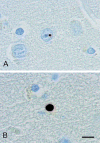Neuronal intranuclear and neuropil inclusions for pathological assessment of Huntington's disease
- PMID: 17493035
- PMCID: PMC8095615
- DOI: 10.1111/j.1750-3639.2006.00040.x
Neuronal intranuclear and neuropil inclusions for pathological assessment of Huntington's disease
Abstract
To evaluate the usefulness of neuronal intranuclear inclusions and neuropil inclusions for the pathological assessment of Huntington's disease (HD), their presence in neocortex was assessed by ubiquitin and N-terminal huntingtin immunohistochemistry in a consecutive series of 195 autopsy brains of individuals with a positive or tentative clinical diagnosis of, or at risk for, HD. The findings were correlated with striatal pathology (n = 190), CAG repeat length (n = 85) and original pathological diagnosis (n = 186). The antibodies detected both these inclusions in 181 patients with HD pathology > or = Vonsattel et al's grade I, five patients lacking striatal tissue for review, and two at-risk individuals with grade 0 and grade I HD pathology, respectively. One patient with HD-like pathology and two patients and four at-risk individuals without HD pathology lacked HD inclusions. In the genetically analyzed cases, the inclusions were exclusively and consistently observed in association with repeat expansion [(CAG)(n) > or = 39, n = 81]. Thirteen inclusion-positive cases, including the grade 0 at-risk individual, had a false negative original pathological diagnosis of HD and four had an unjustly questionable diagnosis. A false positive diagnosis was made in the inclusion-negative case with HD-like pathology. These results indicate that immunohistochemical analysis for HD inclusions facilitates the pathological evaluation of HD and enhances its accuracy.
Figures


Similar articles
-
Intranuclear neuronal inclusions in Huntington's disease and dentatorubral and pallidoluysian atrophy: correlation between the density of inclusions and IT15 CAG triplet repeat length.Neurobiol Dis. 1998 Apr;4(6):387-97. doi: 10.1006/nbdi.1998.0168. Neurobiol Dis. 1998. PMID: 9666478
-
The distribution and density of Huntingtin inclusions across the Huntington disease neocortex: regional correlations with Huntingtin repeat expansion independent of pathologic grade.Acta Neuropathol Commun. 2022 Apr 19;10(1):55. doi: 10.1186/s40478-022-01364-1. Acta Neuropathol Commun. 2022. PMID: 35440014 Free PMC article.
-
Distribution of inclusions in neuronal nuclei and dystrophic neurites in Huntington disease brain.J Neuropathol Exp Neurol. 1999 Feb;58(2):129-37. doi: 10.1097/00005072-199902000-00003. J Neuropathol Exp Neurol. 1999. PMID: 10029096
-
The selective vulnerability of nerve cells in Huntington's disease.Neuropathol Appl Neurobiol. 2001 Feb;27(1):1-21. doi: 10.1046/j.0305-1846.2001.00299.x. Neuropathol Appl Neurobiol. 2001. PMID: 11298997 Review.
-
The early cellular pathology of Huntington's disease.Mol Neurobiol. 1999 Oct-Dec;20(2-3):111-24. doi: 10.1007/BF02742437. Mol Neurobiol. 1999. PMID: 10966117 Review.
Cited by
-
EMQN/CMGS best practice guidelines for the molecular genetic testing of Huntington disease.Eur J Hum Genet. 2013 May;21(5):480-6. doi: 10.1038/ejhg.2012.200. Epub 2012 Sep 19. Eur J Hum Genet. 2013. PMID: 22990145 Free PMC article.
-
Early defect of transforming growth factor β1 formation in Huntington's disease.J Cell Mol Med. 2011 Mar;15(3):555-71. doi: 10.1111/j.1582-4934.2010.01011.x. J Cell Mol Med. 2011. PMID: 20082658 Free PMC article.
-
Postmortem neuropathology in early Huntington disease.J Neuropathol Exp Neurol. 2024 Apr 19;83(5):294-306. doi: 10.1093/jnen/nlae022. J Neuropathol Exp Neurol. 2024. PMID: 38553027 Free PMC article.
-
Neuroanatomic profile of polyglutamine immunoreactivity in Huntington disease brains.J Neuropathol Exp Neurol. 2009 Mar;68(3):250-61. doi: 10.1097/NEN.0b013e318198d320. J Neuropathol Exp Neurol. 2009. PMID: 19225411 Free PMC article.
-
Huntington's disease (HD): degeneration of select nuclei, widespread occurrence of neuronal nuclear and axonal inclusions in the brainstem.Brain Pathol. 2014 Apr;24(3):247-60. doi: 10.1111/bpa.12115. Epub 2014 Mar 3. Brain Pathol. 2014. PMID: 24779419 Free PMC article.
References
-
- Bauer P, Laccone F, Rolfs A, Wüllner U, Bösch S, Peters H, Liebscher S, Scheible M, Epplen JT, Weber BHF, Holinski‐Feder E, Weinrich‐Schwaiger H, Morris‐Rosendahl DJ, Andrich J, Riess O (2004) Trinucleotide repeat expansion in SCA17/TBP in white patients with Huntington’s disease‐like phenotype. J Med Genet 41:230–232. - PMC - PubMed
-
- Becher MW, Rubinsztein DC, Leggo J, Wagster MV, Stine OC, Ranen NG, Franz ML, Abbott MH, Sherr M, MacMillan JC, Barron L, Porteous M, Harper PS, Ross CA (1997) Dentatorubral and pallioluysian atrophy (DRPLA). Mov Disord 12:519–530. - PubMed
-
- Becher MW, Kotzuk JA, Sharp AH, Davies SW, Bates GP, Price DL, Ross CA (1998) Intranuclear neuronal inclusions in Huntington’s disease and dentatorubral and pallidoluysian atrophy: correlation between the density of inclusions and IT15 CAG triplet repeat length. Neurobiol Dis 4:387–397. - PubMed
-
- Braak H, Ghebremedhin E, Rüb U, Bratzke H, Del Tredici K (2004) Stages in the development of Parkinson’s disease‐related pathology. Cell Tissue Res 318:121–134. - PubMed
-
- Bruni AC, Takahashi Fujigasaki J, Maltecca F, Foncin JF, Servadio A, Casari G, D’Adamo P, Maletta R, Curcio SAM, De Michele G, Filla A, El Hachimi KH, Duyckaerts C (2004) Behavioral disorder, dementia, ataxia, and rigidity in a large family with TATA box‐binding protein mutation. Arch Neurol 61:1314–1320. - PubMed
MeSH terms
LinkOut - more resources
Full Text Sources
Medical
Miscellaneous

